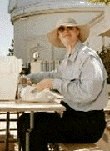|
|
This topic comprises 3 pages: 1 2 3
|
|
Author
|
Topic: Polar Express largest 70mm print order in cinema history
|
Jeffry L. Johnson
Jedi Master Film Handler

Posts: 809
From: Cleveland, Ohio, USA
Registered: Apr 2000
|
 posted 01-12-2005 02:49 PM
posted 01-12-2005 02:49 PM





Original Cinema : the newsletter of the Large Format Cinema Association. Volume X, Number 3 (2005 January).
quote:
An Historic Print Order
In completing Polar Express for IMAX 3-D and shipping it to nearly 70 Large Format theaters in North America, David Keighley and the team at DKP/70mm Inc. were dealing with some big numbers. "It's the biggest 70mm print order in cinema history," says Keighley. "Star Wars used 250 70mm prints in the 1970s. That would be 3.2 million feet. This release is 5.5 million feet. It's also got other parameters. All those prints put end-to-end, the left and right eye, are almost 1000 miles long. Each print is about 14 miles long. Each print goes into ten boxes which hold the 30 reels left eye and 30 reels right eye. That weighs 661 pounds. There are almost 290,000 frames in the film. At 4k that's 7.3 terabytes. So that's 7 trillion pieces of data.
To project Polar Express 3-D as a feature film, new 150-minute platters had to be built for the theaters. Separate platters hold the left eye and right eye prints which run in tandem through the projector.
The IMAX effort to produce a LF 3-D version of The Polar Express seems to have paid off. After only eleven days in release in North America, it had grossed a total of almost $6 million.
| IP: Logged
|
|
|
|
|
|
|
|
|
|
|
|
Kyle McEachern
Expert Film Handler

Posts: 165
From: San Francisco, CA
Registered: Feb 2004
|
 posted 01-13-2005 05:23 AM
posted 01-13-2005 05:23 AM


quote: Brad Miller
And how many millions did the 35mm prints make in the first eleven days in release? Of the $6 million from IMAX tickets, how many of those customers would've seen it in 35mm if the IMAX version had not existed?
A better question would be "what was the average dollar amount PER SCREEN that the movie brought in in 35mm in the first eleven days, vs. IMAX?" -- there was an initial order of 65 prints (According to DKP) for Polar Express, and assuming no extras were added in the first 11 days, that would be just over $92,000 per screen in 11 days...pretty impressive for LF theatres, competing with the thousands of 35mm ones that had the film. And as to the second half of the question, most of the customers who saw it at my theatre seemed to have already seen it in 35mm (granted, we got the movie about two weeks after its inital release), and we still sell out weekend shows and sold out almost every show for the first two weeks.
As to the facts of the original quote, they're slightly different than the ones given by David Keighley Productions initially. This is from a sheet sent out by DKP along with the Polar Express print to IMAX Projectionists:
quote:
Here are some answers to FAQs:
- 289,574 frames were digitally recorded. We belive this is the longest digital intermediate (DI) negative recorded to date anywhere and that these 4K frames equal 7.3 terabytes of data. That's 7.3 trillion bytes of data, in case you're counting
- Each print weighs 661.5 lbs in boxes
- Each print of 30 left eye and 30 right eye reels is 73,845 feet or 13.98 miles long
- The initial order of 65 3D prints is the largest 70mm print footage order in cinema history at 4.94 million feet
- Sixty-Five prints of The Polar Express: An IMAX Experience is 908.7 miles of 70mm film
- 3,900 reels of film were processed
- 4,550 boxes were assembled for shipping
- 11,700 labels identify each individual reel
- 42,997.5 lbs, or 21.49 tons of film has been shipped for the inital 65 print order
That's all well and good...but my question is on:
11,700 labels identify each individual reel
I think they could have worded it better...either that or they used 45,630,000 labels (11700 * 3900 reels). That's a lot of labels, hope it doesn't leave residue.
| IP: Logged
|
|
|
|
|
|
Brian Michael Weidemann
Expert cat molester

Posts: 944
From: Costa Mesa, CA United States
Registered: Feb 2004
|
 posted 01-16-2005 05:21 AM
posted 01-16-2005 05:21 AM





quote: Dick Vaughan
150 minute platters have been around for at least 3 years and anyway PE is only 101 minutes so will fit on any platter larger than ,and including, the 60" "90 minute" platter.
This original point was probably trying to allude to the fact that, while the 150 has existed, many QTRU's needed to be upgraded, on account of this movie, so that FOUR decks could run 150's. As is the case with us. Our decks 4 and 5 could run 150, but 1, 2, and 3 could only do 60's.
Poor wording causes so much confusion. There was a newspaper article a month ago about this and it led the reader to believe that IMAX projectors have been running 35mm prints forever, but this "DMR" thing just makes them look better. I also saw a "clarification" that 15/70 means "15mm by 70mm". Hmmm ... that's skinnier than a 35mm frame!
| IP: Logged
|
|
|
|
|
|
Brian Michael Weidemann
Expert cat molester

Posts: 944
From: Costa Mesa, CA United States
Registered: Feb 2004
|
 posted 01-24-2005 03:32 AM
posted 01-24-2005 03:32 AM





quote: Brad Miller
Of the $6 million from IMAX tickets, how many of those customers would've seen it in 35mm if the IMAX version had not existed?
Regarding the first few weeks of the film's release, I'm sure the answer is a significant amount. Now, however, over two months after the fact, our IMAX version is still pulling in a lot of people. Our 35mm print is ... oh, wait, we lost that a month ago! If we had a 35mm print of Polar Express now, and NOT an IMAX, it wouldn't do any business at all. (Well, does anyone still have it in 35mm and can confirm or deny?)
In fact, the business it's doing now--for ANY movie two months after its release--is actually impressive. Amazingly. Neither of the Matrix sequels were still attracting patrons after this long.
quote: Mark Gulbrandsen
but only because of its format.
Well, there you go! If it's true in ANY capacity, then it's fair game to be used to promote the film. Every marketing department EVERYWHERE is guilty of this, I'm sure. Oh, this is the the first time that over 1000 computers were networked to render the darned thing ... oh, this is the first time every print was personally viewed by the director for quality assurance ... oh, this is the longest film ever that was produced in the time it took ...
Whatever the gimmick is, someone'll point it out. And really, what does it all mean when it comes down to it? A whole heck of not a lot. ![[Razz]](tongue.gif)
| IP: Logged
|
|
|
|
|
|
|
|
All times are Central (GMT -6:00)
|
This topic comprises 3 pages: 1 2 3
|
Powered by Infopop Corporation
UBB.classicTM
6.3.1.2
The Film-Tech Forums are designed for various members related to the cinema industry to express their opinions, viewpoints and testimonials on various products, services and events based upon speculation, personal knowledge and factual information through use, therefore all views represented here allow no liability upon the publishers of this web site and the owners of said views assume no liability for any ill will resulting from these postings. The posts made here are for educational as well as entertainment purposes and as such anyone viewing this portion of the website must accept these views as statements of the author of that opinion
and agrees to release the authors from any and all liability.
|

 Home
Home
 Products
Products
 Store
Store
 Forum
Forum
 Warehouse
Warehouse
 Contact Us
Contact Us




 Printer-friendly view of this topic
Printer-friendly view of this topic












![[Smile]](smile.gif) ]
]

![[Razz]](tongue.gif)
![[Roll Eyes]](rolleyes.gif)



